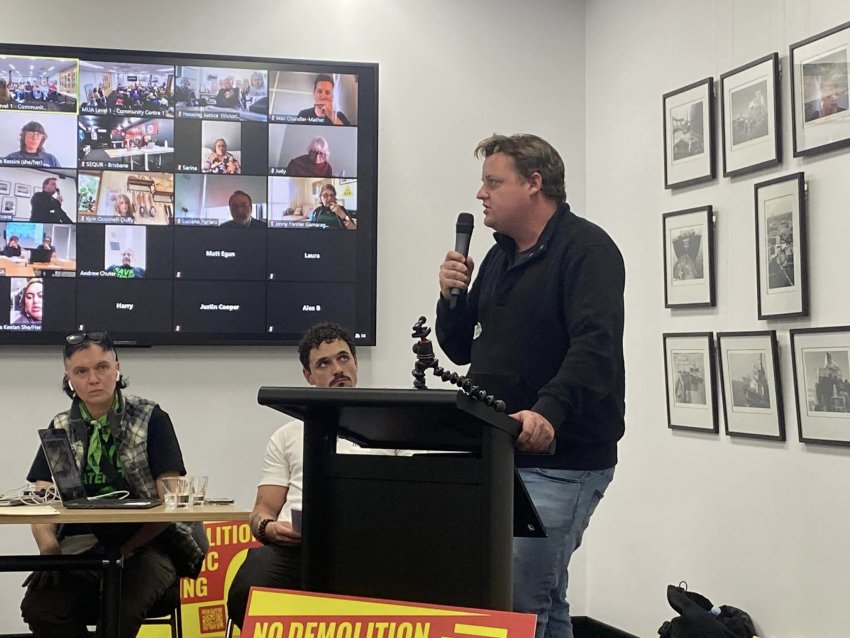
Zach Smith, Construction, Forestry, Maritime, Mining and Energy Union (CFMEU) national secretary told the Housing Justice Summit on October 8 that a rich country has to be able to provide a roof over everyone’s heads.
“How can we say we are a rich nation when governments of all persuasions have waged war on public housing over the last four decades?” he asked.
Smith told the 200-strong summit, initiated by Action for Public Housing, the problem is that “housing is seen as a commodity, a legacy of negative gearing”.
Federal Greens MP Max Chandler-Mather, another keynote speaker, said understanding Australia’s financialised housing system helps explain Labor’s inadequate response. It also helps activists formulate their response.
Commenting on Labor’s plan, Smith said the housing packages, including the “worthwhile” ones, will exacerbate the crisis. He said the state does have to play a role in building 950,000 new homes.
“Our union is campaigning for half a trillion, or $28 billion a year, to go straight to public and affordable housing to close the gap.”
He said the funds could be raised by taxing the super rich — about 0.3% of businesses — raising around $290 billion in the first decade.
Dr David Kelly from the RMIT’s Centre for Urban Design criticised the Victorian government’s “fire sale” of public housing. It has a plan to demolish 44 public housing towers in gentrified high amenity areas.
“That’s one tower demolished every nine months over the next 30 years. That’s 10,000 households displaced because the government said the towers are ‘not fit for modern living’. “We all know forced displacement knocks years off people’s lives and disintegrates communities,” Kelly said.
Lilia Anderson from The Australia Institute said “big picture solutions” such as building public housing, are needed now.
“Between 1996 and 2016, the population increased by 30% but social housing stock grew by just 4%. New social housing built has not kept pace with the rise in migration.
“Every year the proportion of social housing as a proportion of the population has been going backwards and the waiting list has grown.” She said more than 175,000 people were on the list last year.
Public housing was a priority between 1945 and 1956 when around 125,000 dwellings were built. But, by the end of the 1960s, public housing accounted for just 18% of housing in South Australia, 14% in Western Australia, 10% in Queensland, 7% in Victoria and 6% in NSW.
The now privatised Sirius building in Sydney, the Waterloo towers and Melbourne’s Carlton and Fitzroy towers were all built in the 1960s and early 1970s.
Anderson said governments started walking away from public housing from the 1980s. She said a “neoliberal view” is behind government arguments that private providers are better. “Public housing became to be seen as a liability rather than an asset.”
She said government builds of public housing had accounted for 16% of annual completions between 1945 and 1970. By the mid-1990s, this had dropped to just 3%.
Chandler-Mather said the 1990s shift in bank lending from predominantly business loans to housing and property loans and the deregulation of the finance sector in the 1980s and 1990s had financialised the housing system.
“There used to be a lot of rules around who banks could and couldn’t lend to … those were all removed. The government set up the secondary mortgage market which allowed banks to bundle mortgages together and sell and trade them on financial markets.”
He said the Prices and Income Accords of the 1990s also helped in the transfer of wealth and power to the banking and finance sector.
As a greater proportion of the population are struggling with housing repayments and rents, Liberal and Labor governments and the property sector are all arguing that it’s a “problem of supply”.
“They’ve used this as an excuse to aggressively sell off public housing and claim that an increase in supply of private housing will fix the housing crisis. Chandler-Mather said selling off public land “for cheap” is providing another huge subsidy to the private property market.
“What [Labor] is doing is not just giving money to property investors, they are adding a stimulus payment into the economy to ensure the financialisation of housing continues. That’s what those payments are going to do.”
Chandler-Mather said the total private rent paid from 2014 to 2023 was $440 billion. “If you’re a renter, like me, you’ve helped to contribute almost half $1 trillion, transferred from renters to property investors, landlords and, ultimately, to the finance industry.”
He said the opposition to caps and freeze on rents and mass investment in public and affordable housing is frustrating, and there needs to be a “social power” to confront it.
Ishbel Dunsmore, representing the University of Sydney Student Representative Council, spoke passionately about students not being able to afford rent, including in university accommodation, let alone eating well and having a social life.
Public housing tenants and campaigners Carolyn Ienna, Karyn Brown, Margaret Kelly and Kerrie Byrne spoke about their respective struggles to stop the demolition of public estates.
Contributions to a session on the campaign fight back included Andrew Tiggjan from the South East Queensland Union of Renters, Dr Alistair Sisson from Action for Public Housing NSW; Margaret Kelly and JR Hewitt from Save Barak Beacon campaign; Samantha Skinner from the Anti-Poverty Network South Australia and Jesse Noackes, a Western Australian climate campaigner and activist with House the Homeless WA.
The National Housing Justice Summit was organised and endorsed by 24 organisations.
[Watch speeches from the Housing Justice Summit here.]